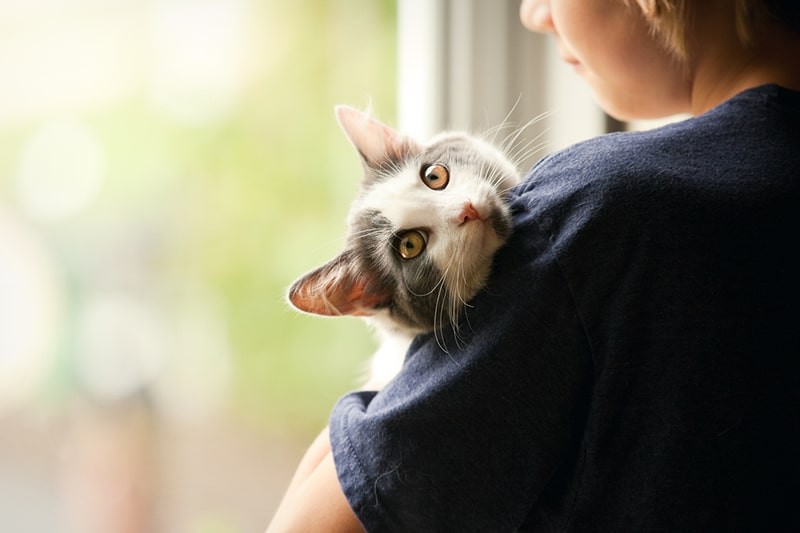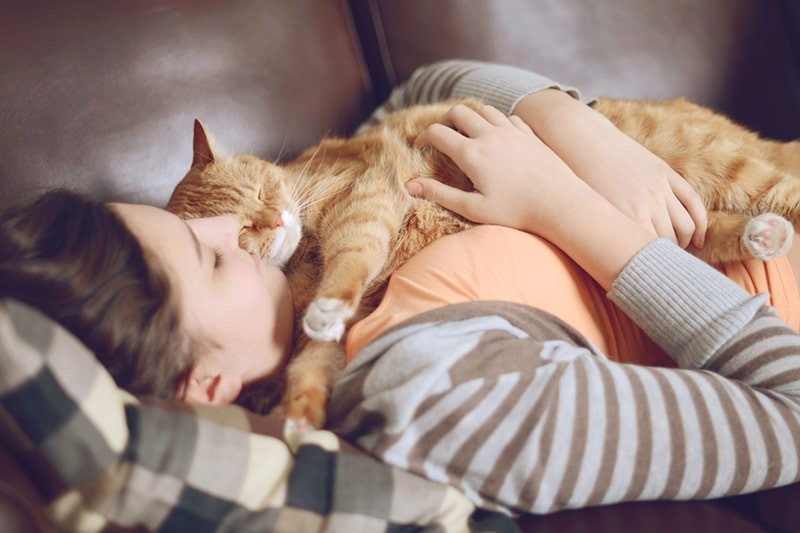How Much Does A Cat Cost Per Month? Discover the true cost of cat ownership with this expert guide from HOW.EDU.VN, covering everything from food and vet care to unexpected expenses. This comprehensive resource helps you budget wisely, ensuring a happy and healthy life for your feline friend. Explore insightful advice, cost-saving tips, and expert guidance to manage your monthly cat expenses effectively.
1. Understanding the Initial Costs of Cat Ownership
Adopting a cat is an exciting step, but understanding the initial financial commitment is crucial. The primary cost you’ll encounter is the adoption fee if you choose to adopt from a shelter. These fees vary depending on the shelter and the cat’s age, typically ranging from $50 to $175. Many shelter cats come already spayed or neutered, microchipped, and initially vaccinated, reducing your upfront costs. Alternatively, purchasing a cat from a breeder can be significantly more expensive, often exceeding $750. HOW.EDU.VN strongly recommends adopting from shelters where numerous cats and kittens await loving homes.
1.1. Adoption vs. Breeding: A Cost Comparison
Choosing between adopting from a shelter and buying from a breeder significantly impacts initial costs. Shelters often have lower adoption fees, and these fees frequently include essential veterinary services. Breeders, particularly those specializing in specific breeds, charge higher prices, reflecting the care and pedigree of the animals.
| Factor | Shelter Adoption | Breeder Purchase |
|---|---|---|
| Initial Cost | $50 – $175 (typically includes vet services) | $750+ (costs often do not include initial vet care) |
| Health Records | Often available, may include initial vaccinations | Usually detailed, including lineage and health history |
| Socialization | Varies; often cats are socialized within the shelter | Usually well-socialized, especially in reputable breeders |
| Ethical Considerations | Supports animal rescue and reduces overpopulation | May contribute to demand for specific breeds |


1.2. Essential One-Time Purchases
Beyond adoption fees, several one-time purchases are necessary to welcome a cat into your home. These include a litter box, carrier, collar with an ID tag, and scratching posts or mats. The ASPCA estimates that initial capital costs for a cat average around $365, including initial medical care and spaying or neutering. However, this figure can fluctuate based on your specific choices.
2. Breaking Down Monthly Cat Expenses
Understanding ongoing monthly expenses is vital for responsible cat ownership. According to the ASPCA, the average annual cost of owning a cat is approximately $634, which translates to about $53 per month. This covers recurring medical expenses, cat food, treats, and toys. However, individual circumstances can significantly alter these costs.
2.1. Recurring Medical Expenses
Regular veterinary care is essential for maintaining your cat’s health. This includes annual check-ups, vaccinations, and preventative medications for fleas, ticks, and heartworms. These expenses can vary widely depending on your geographic location and the specific needs of your cat.
2.2. Cat Food Costs
The type of cat food you choose significantly impacts your monthly expenses. High-quality cat food, tailored to your cat’s age and lifestyle, is crucial for their well-being. Consulting with your veterinarian about healthy food choices can help you make informed decisions.
2.3. Treats and Toys
Treats are excellent for training, but moderation is key due to their high caloric content. Toys provide essential physical and mental stimulation, preventing boredom and undesirable behaviors. Investing in a variety of safe and engaging toys is a worthwhile monthly expense.
2.4. Additional Monthly Costs
Depending on your lifestyle, additional monthly expenses may arise. These include hiring a cat sitter if you work long hours or boarding fees if you travel frequently. Apartment or condo owners may also encounter pet fees, covering potential damages.
3. Unexpected Costs: Planning for the Unforeseen
Despite careful planning, unexpected costs can emerge. Damage to your home from scratching or spraying can lead to repair expenses. Additionally, unforeseen veterinary bills due to accidents or illnesses can be significant.
3.1. Common Cat Health Issues and Their Costs
Cats are susceptible to various health issues, some of which can be costly to treat. Common problems include urinary tract infections, dental diseases, and injuries from falls or accidents.
| Health Issue | Average Cost of Treatment | Preventative Measures |
|---|---|---|
| Urinary Tract Infection | $200 – $500 | Adequate hydration, proper diet |
| Dental Disease | $500 – $2000+ | Regular dental check-ups, dental treats |
| Accidental Injuries | $500 – $5000+ | Cat-proofing home, supervised outdoor access |
| Upper Respiratory Issues | $100 – $300 | Maintaining a clean environment, vaccinations |
3.2. The Role of Pet Insurance
Pet insurance can provide a financial cushion, helping manage unexpected veterinary bills. The cost of pet insurance varies based on coverage, the cat’s age, and breed. Balancing coverage and cost is essential when choosing a plan.
4. Maximizing Savings on Cat Costs
While cat ownership involves expenses, numerous strategies can help you save money without compromising your cat’s well-being.
4.1. Smart Shopping Strategies
Purchasing food and supplies in bulk can significantly reduce costs. Comparing prices across different stores and online retailers ensures you get the best deals.
4.2. DIY Alternatives
Creating your own cat toys and treats is a cost-effective and engaging way to provide enrichment. Simple homemade toys, such as those made from cardboard boxes and fabric scraps, can be just as appealing to cats as store-bought items.
4.3. The Benefits of Preventative Care
Investing in preventative care, such as regular vet check-ups and vaccinations, can prevent more costly health issues down the line. Ensuring your cat drinks plenty of water, eats a healthy diet, and gets adequate exercise contributes to their overall well-being, reducing the likelihood of expensive vet visits.
5. The True Value of Cat Ownership
While the costs associated with cat ownership are important to consider, the emotional and psychological benefits are invaluable. Cats offer companionship, reduce stress, and bring joy to their owners’ lives. Balancing financial considerations with the profound rewards of pet ownership is key to a fulfilling experience.
5.1. The Emotional Benefits of Owning a Cat
Studies have shown that cat ownership can lower blood pressure, reduce anxiety, and increase feelings of social support. The simple act of petting a cat can release endorphins, promoting relaxation and well-being.
5.2. Balancing Cost and Care
Responsible cat ownership involves providing adequate care while managing expenses effectively. Prioritizing essential needs, such as quality food and veterinary care, ensures your cat thrives. Exploring cost-saving strategies and being prepared for unexpected expenses allows you to enjoy the companionship of your feline friend without undue financial stress.
6. Expert Veterinary Advice at HOW.EDU.VN
For personalized advice on managing your cat’s health and well-being, turn to the experts at HOW.EDU.VN. Our team of over 100 renowned PhDs provides tailored consultations to address your specific concerns.
6.1. Personalized Consultations
At HOW.EDU.VN, you can connect directly with experienced veterinarians and animal care specialists. Whether you need advice on nutrition, behavior, or healthcare, our experts offer evidence-based guidance to help you make informed decisions.
6.2. Accessing Expert Insights
Our platform offers a wealth of resources, including articles, webinars, and Q&A sessions with leading experts. Stay informed about the latest advancements in veterinary medicine and best practices for cat care.
7. Understanding the Intention Behind Your Search
When people search for “how much does a cat cost per month,” they often have distinct intentions. Understanding these intentions helps provide targeted and valuable information.
7.1. Budget Planning
Many individuals are trying to determine the financial feasibility of owning a cat. They need a detailed breakdown of monthly expenses to assess whether they can afford to provide adequate care.
7.2. Cost Comparison
Prospective cat owners often compare the costs of owning a cat versus other pets, such as dogs or smaller animals. They are looking for a clear understanding of the financial commitment involved.
7.3. Identifying Hidden Costs
Some individuals are aware of basic costs but want to uncover potential hidden expenses. They seek insights into unexpected veterinary bills, specialized diets, or additional services like grooming or boarding.
7.4. Finding Cost-Saving Tips
Many cat owners are looking for ways to reduce their monthly expenses without compromising their cat’s well-being. They are interested in practical tips for saving money on food, supplies, and healthcare.
7.5. Validating Their Spending
Current cat owners may be curious to see if their current spending aligns with average costs. They want to ensure they are not overspending and are providing adequate care within a reasonable budget.
8. Real-World Scenarios and Case Studies
Illustrating the costs and benefits of cat ownership through real-world scenarios and case studies provides practical insights. These examples highlight the importance of planning and preparedness.
8.1. Case Study: The Importance of Pet Insurance
Sarah adopted a kitten and initially declined pet insurance to save money. However, within a year, the kitten developed a severe urinary tract infection requiring multiple vet visits and specialized treatment. The unexpected bills totaled over $2,000. Sarah realized that pet insurance would have significantly reduced her financial burden.
8.2. Scenario: Balancing Food Quality and Cost
Mark wanted to provide the best possible nutrition for his cat but was concerned about the high cost of premium cat food. He consulted with a veterinarian at HOW.EDU.VN, who recommended a balanced approach. Mark opted for a high-quality dry food as the base diet, supplemented with occasional servings of wet food and homemade treats. This strategy allowed him to provide excellent nutrition while staying within his budget.
9. Detailed Breakdown of Cat Care Categories and Costs
To provide a comprehensive understanding of monthly cat expenses, a detailed breakdown of various care categories and their associated costs is essential.
9.1. Food and Nutrition
The cost of cat food varies depending on the brand, quality, and type (dry, wet, or raw). High-quality dry food typically costs between $30 and $60 per month, while wet food can range from $50 to $100 or more, depending on the frequency of feeding.
9.2. Litter and Waste Management
Litter costs depend on the type (clay, clumping, crystal) and the number of cats. On average, cat owners spend between $15 and $40 per month on litter. Additional waste management costs may include disposal bags and litter box liners.
9.3. Veterinary Care
Monthly veterinary costs vary depending on the cat’s health and age. Routine check-ups, vaccinations, and preventative medications typically cost between $20 and $50 per month. Emergency or specialized care can significantly increase these expenses.
9.4. Grooming and Hygiene
Grooming costs depend on the cat’s breed and coat length. Short-haired cats require minimal grooming, while long-haired breeds may need professional grooming services. Monthly grooming costs can range from $0 to $50 or more.
9.5. Toys and Enrichment
Providing toys and enrichment is essential for a cat’s mental and physical well-being. Monthly costs for toys can range from $10 to $30, depending on the quality and variety.
9.6. Miscellaneous Expenses
Miscellaneous expenses may include catnip, scratching posts, cleaning supplies, and other incidental items. These costs can range from $10 to $30 per month.
10. Frequently Asked Questions (FAQ) About Cat Costs
Addressing common questions about the costs of cat ownership can provide clarity and reassurance to prospective and current cat owners.
10.1. What is the average monthly cost of owning a cat?
The average monthly cost of owning a cat ranges from $50 to $100, depending on various factors such as food quality, veterinary care, and lifestyle.
10.2. How much does cat food typically cost per month?
Cat food costs typically range from $30 to $60 per month for high-quality dry food, and $50 to $100 or more for wet food.
10.3. How much should I budget for vet visits each year?
Budgeting $200 to $500 per year for routine vet visits and vaccinations is a good starting point. Emergency or specialized care may require additional funds.
10.4. Is pet insurance worth the cost?
Pet insurance can be worthwhile for managing unexpected veterinary bills. The cost depends on the coverage and the cat’s age and breed.
10.5. How can I save money on cat care?
You can save money by buying in bulk, making your own toys and treats, and investing in preventative care.
10.6. What are the essential items I need to buy when I first get a cat?
Essential items include a litter box, carrier, collar with an ID tag, scratching posts, food and water bowls, and cat food.
10.7. How often should I take my cat to the vet?
You should take your cat to the vet for annual check-ups and vaccinations. More frequent visits may be necessary for older cats or those with health issues.
10.8. What are some common health problems that can be expensive to treat?
Common health problems include urinary tract infections, dental diseases, accidental injuries, and upper respiratory issues.
10.9. Can I use human shampoo on my cat?
No, you should only use shampoo specifically formulated for cats. Human shampoo can be harmful to their skin and coat.
10.10. How do I know if I am feeding my cat the right amount of food?
Consult with your veterinarian to determine the appropriate amount of food for your cat’s age, weight, and activity level.
Call to Action
Are you looking for expert advice on managing your cat’s health and expenses? Contact HOW.EDU.VN today to connect with our team of renowned PhDs. Get personalized consultations and evidence-based guidance to ensure your feline friend thrives. Visit how.edu.vn or call us at +1 (310) 555-1212. Our address is 456 Expertise Plaza, Consult City, CA 90210, United States.

